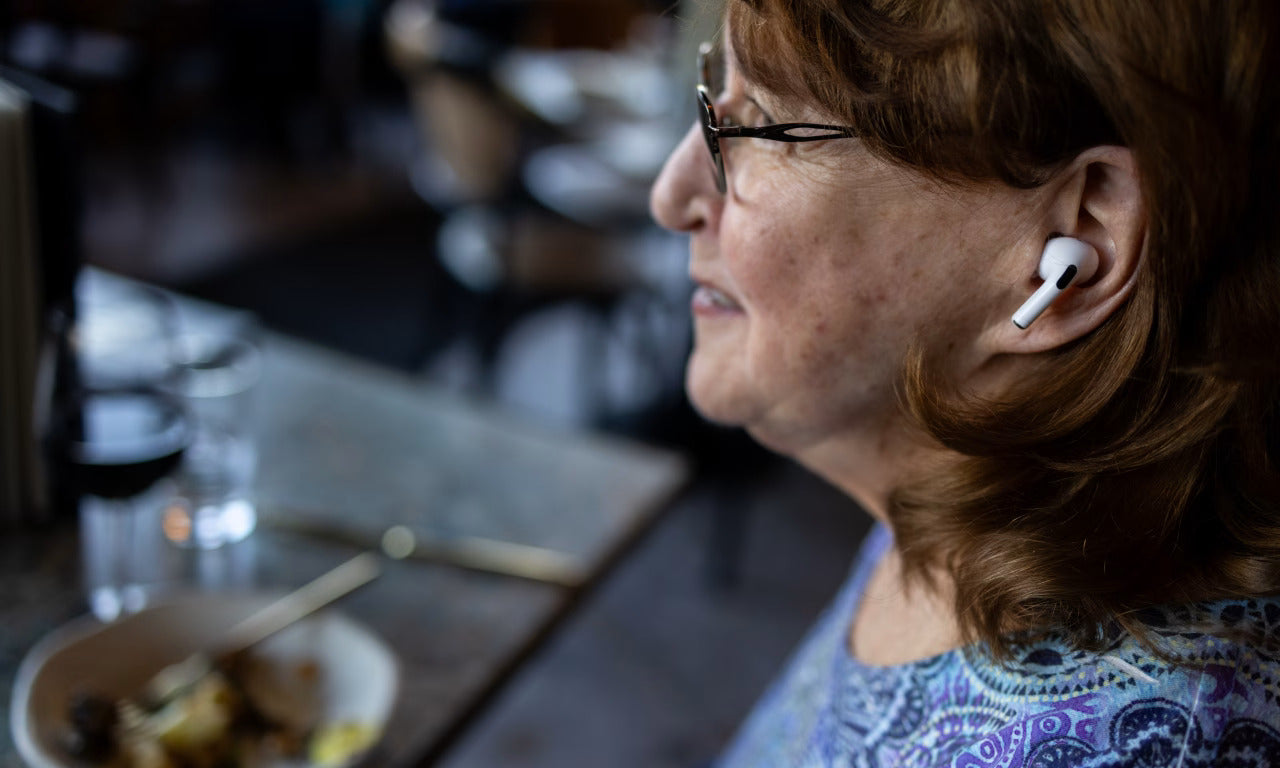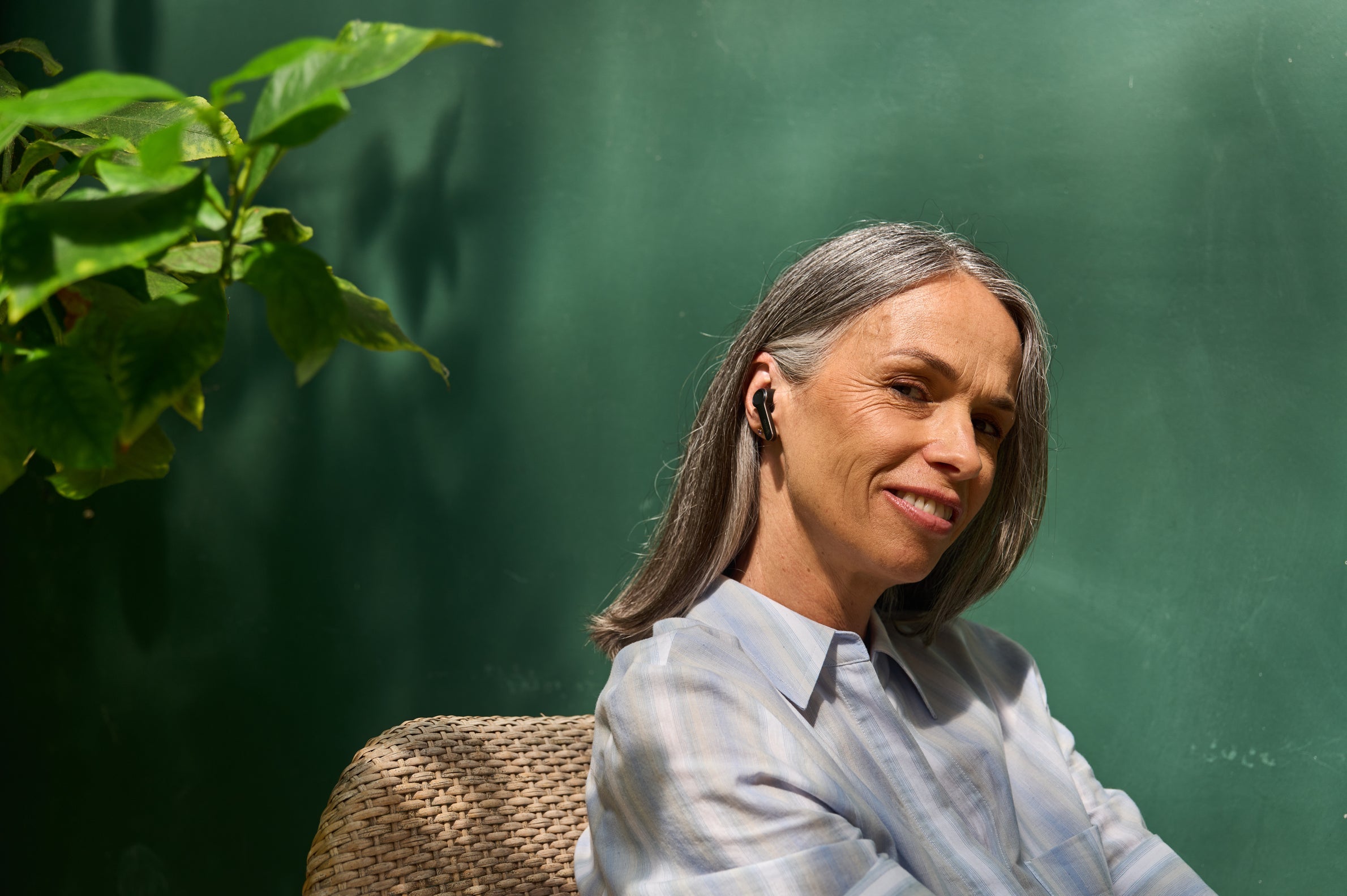Have you ever wondered if your Apple AirPods could double as hearing aids?
You're not alone.
More and more people—especially older adults with mild hearing loss—are exploring whether using AirPods as hearing aids is a smart and affordable option. After all, they're already in your ears, they're wireless, and they connect easily to your iPhone. Sounds convenient, right?
But while it's tempting to use what you already have, it's important to understand how this works, what the limitations are, and when it might be time to consider real hearing support.
In this guide, I'll walk you through everything you need to know about AirPods as hearing aids, from what models work best to how to set them up, and when it makes sense to upgrade to true OTC hearing aids like Cearvol Diamond X1.
Let's start with why this idea became so popular in the first place.
🚀 Navigate This Post
- ➤ Part 1: Why People Are Using AirPods as Hearing Aids
- ➤ Part 2: What AirPods Work as Hearing Aids Best?
- ➤ Part 3: How to Use AirPods as Hearing Aids – Setup Guide
- ➤ Part 4: Pros and Cons of Using AirPods Instead of Hearing Aids
- ➤ Part 5: When to Choose Real Hearing Aids Instead
- ➤ Part 6: Final Thoughts – Is It Worth It?
- ➤ Frequently Asked Questions
You may also be interested in:
- Cool, Practically Invisible and Stylish Hearing Aids: Meet the New Era of Hearing Aids
- Top 5 Features to Consider When Buying Best Bluetooth Hearing Aids
- We Compared Cearvol and Oracle Hearing Aids – Here's What You Need to Know
Part 1: Why People Are Using AirPods as Hearing Aids
For many older adults, hearing loss happens gradually. You might find yourself turning up the TV a little louder, asking people to repeat themselves, or struggling in noisy places. But seeing a hearing specialist or investing in a pair of hearing aids? That can feel like a big step.

That's where Apple's Live Listen feature caught people's attention. Introduced in iOS, this tool allows your iPhone's microphone to pick up sound and transmit it directly to your AirPods—almost like a hearing aid. Just like that, the idea of "AirPods as hearing aids" became a trending solution.
Why it's appealing:
-
Convenience – You already have the device in your ears.
-
Discreetness – It doesn't look like a hearing aid, which can feel less stigmatizing.
-
Affordability – Hearing aids can be expensive. Do I need to spend thousands on custom hearing aids? Not necessarily—but many people still hesitate at the price.
And for some, especially those with mild hearing issues, this setup can help in specific scenarios—like dinner conversations, watching TV, or chatting at the doctor's office.
But it's also worth noting: AirPods are not FDA-approved hearing aids, and using them as a substitute may not provide the level of clarity or personalization that many people truly need.
To understand the limitations, we first need to know: Which AirPods can actually function this way—and how well?
Part 2: What AirPods Work as Hearing Aids Best?
Not all AirPods are created equal when it comes to helping you hear better.
To use the Live Listen feature—which is Apple's way of turning AirPods into a kind of hearing amplifier—you need a compatible set of AirPods and an iPhone or iPad with the right software. Here's a breakdown of which ones work best:
Compatible AirPods for Live Listen:
-
AirPods Pro (1st and 2nd generation) – These are the most popular for hearing enhancement because they include active noise cancellation and better sound isolation.

-
AirPods Max – Apple's over-ear headphones also support Live Listen and provide strong sound clarity, though they may be too bulky for some seniors.
-
Standard AirPods (2nd gen or newer) – They work too, but the results are limited. Without noise cancellation or in-ear fit, background noise can overwhelm what you want to hear.
💡 Tips:
To use Live Listen, your device must run iOS 12 or later. Most people today meet that requirement without issue.
So, if you're wondering "can AirPods be used as hearing aids?" the answer is yes—but only some models will actually deliver a meaningful benefit, especially in noisy environments.
Still unsure which tech is right for your needs? You might find this article helpful: Apple AirPods Hearing Aids or Cearvol?
Part 3: How to Use AirPods as Hearing Aids – Setup Guide
If you have a compatible pair of AirPods and an iPhone, setting up Live Listen is surprisingly easy. Here's a step-by-step guide to help you get started:
What You’ll Need
- Fully charged AirPods (any model that supports Transparency Mode)
- A paired iPhone or iPad running the latest iOS/iPadOS
- Health app (optional for importing audiograms)
Step-by-Step Setup
- Put your AirPods in your ears and connect them to your iPhone or iPad.
- Go to Settings > [Your AirPods Name].
- Tap Hearing Assistance.
- If you haven’t yet, take a Hearing Test, or tap Use a Prior Test Result if available.
- Tap Set Up Hearing Aid, then tap Get Started and Turn On Hearing Aid.
Adjust Hearing Settings
You can fine-tune how your AirPods amplify the environment using the following settings:
| Setting | Description |
|---|---|
| Amplification | Controls how much surrounding sound is boosted. |
| Balance | Shifts volume between left and right AirPods. |
| Tone | Adjusts the brightness or softness of amplified sound. |
| Ambient Noise Reduction | Minimizes background noises like fans or traffic. |
| Conversation Boost | Improves speech clarity when talking face-to-face. |
Control from Control Center
- On iPhone/iPad: Open Control Center → Long press the volume slider → Adjust amplification separately from media volume.

- On Apple Watch: Control Center → Tap the Hearing Aid icon → Slide to adjust amplification.

- On Mac: Go to System Settings → Your AirPods → Hearing Health → Make adjustments.

Enable Conversation Boost
- Go to Settings > AirPods > Hearing Assistance > Adjustments.
- Turn on Conversation Boost.
- You can also access this toggle via Control Center.
💡 Tips:
Changes you make will stay active even when your iPhone isn't nearby, as settings are stored directly on your AirPods.
This setup allows you to hear more clearly in close-range conversations, small groups, or even while watching TV. But remember—this isn't the same as a medically calibrated hearing aid.
If you find yourself constantly relying on this function, that might be your sign to explore a proper hearing solution. And yes, today's OTC options are more user-friendly than ever. Just look at how easy it is to connect hearing aids to Bluetooth, similar to your AirPods.
Part 4: Pros and Cons of Using AirPods Instead of Hearing Aids
Let's be honest: using AirPods as hearing aids sounds smart. And for some, it's a handy temporary solution. But like all things in life, there are trade-offs.
Pros:
-
Discreet look – AirPods don't look medical, which helps reduce stigma.
-
Easy to set up – No appointments, just a few taps on your iPhone.
-
Affordable (short-term) – If you already own AirPods, there's no extra cost.
Cons:
-
Not designed for hearing loss – AirPods amplify sound, but they don't personalize frequencies to your hearing profile.
-
Battery drains fast – They're not optimized for all-day listening like real hearing aids.
-
No professional fitting – Missing out on expert tuning can lead to frustration or ear fatigue.
Also, if you're in a loud restaurant or crowded space, AirPods struggle to separate voices from noise—an area where real hearing aids, like the background noise reduction models, shine.
Want to explore how real hearing aids can do better? Here's a comparison worth checking out: Hearing aids and amplifiers – which is better?
Part 5: When to Choose Real Hearing Aids Instead
If you find yourself constantly needing Live Listen, turning up the volume, or avoiding conversations due to hearing strain, it might be time to move beyond AirPods.
Here's when real OTC hearing aids may be a better fit:
-
You struggle to follow conversations even in quiet settings
-
You experience tinnitus or ear ringing
-
You feel isolated or avoid social gatherings due to hearing
Devices like Cearvol Diamond X1 are designed with seniors in mind: easy to use, discreet in design, and medically tuned for mild to moderate hearing loss.

Diamond X1 - Best Hearing Aids with Bluetooth
Newcomer Price
$249.99 $309.99
- ✔ Adaptive sound modes for clear hearing.
- ✔ Bluetooth for calls & streaming.
- ✔ App-controlled, customizable adjustments.
- ✔ Rechargeable & fast charging.
- ✔ Ideal for mild to moderate hearing loss.
They also come with long battery life and advanced noise filtering—something your AirPods simply can't offer. And if you're new to hearing aids, here are some helpful first-time tips to make the transition smoother.
Part 6: Final Thoughts – Is It Worth It?
So, can AirPods be used as hearing aids? Yes, and they may help in some casual or temporary situations.
But for long-term hearing health, personalized clarity, and real comfort, they're not a replacement for proper hearing aids. The good news? You no longer need a prescription or a high-end audiologist visit. Brands like Cearvol now offer affordable, Bluetooth-ready hearing aids that are built for people just like you.
Hearing better shouldn't be a luxury—and you deserve to enjoy every conversation, every laugh, and every song clearly.
Frequently Asked Questions




コメントを書く
全てのコメントは、掲載前にモデレートされます
このサイトはhCaptchaによって保護されており、hCaptchaプライバシーポリシーおよび利用規約が適用されます。